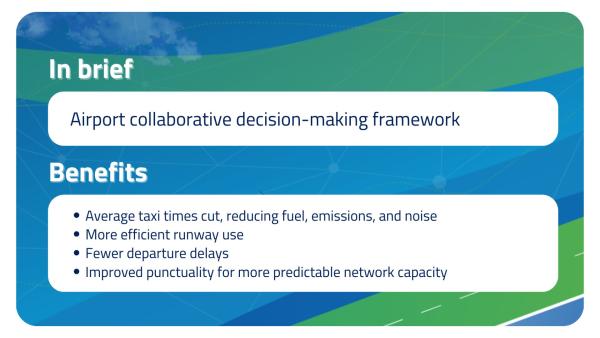Synchronising departure management starts with pre-departure sequencing
SESAR uses taxiway routing and planning information to calculate more accurate taxi-out times and deliver an optimal traffic flow to the runway.
Knowing that airports need a steady departure flow to make the best use of a runway, SESAR set out to strengthen pre-departure sequencing processes. The key to doing so: enabling different stakeholders – from air traffic control to ramp management and the EUROCONTROL Network Manager – to share up-to-date information. Not only does this minimise waiting times at the runway holding point, it also helps reduce fuel use, emissions, and noise.

On-time departures depend on many actors working together to coordinate passenger boarding, ground handling, gate management and access to taxiways and departure routes before pushback. Timely updates become even more important during variable events, such as unexpected weather, runway closures or winter de-icing operations.
Inconsistent information exchange or static data adds to the difficulty of sequencing aircraft prior to departure and can result in longer taxi times or extra holding to manage traffic flow. This in turn increases fuel use and emissions and contributes to departure delays.
While the use of rolling network operations plans (NOP) means all parties share a common view of the network situation, there is room for improvement.
By supporting the integration of airport operational data and adding more data at the regional level, SESAR is helping stakeholders exercise operational preferences and work towards delivering efficient departure sequencing.
The solution
A collaborative decision making (CDM) framework that:
- Supports automated data exchange
- Accurately calculates departure sequencing using such processes as airport collaborative decision making (A-CDM) and a departure manager (DMAN)
The results
SESAR trials using dynamic route planning information resulted in more accurate calculations of the departure sequence. The trials showed how this solution can improvepredictability and stability of both target and actual times (SESAR solution #53(1)).
The details
- SESAR research focused on using DMAN, in combination with the advanced surface guidance and control system (A-SMGCS), to increase taxi-out accuracy and provide the EUROCONTROL Network Manager with more accurate departure data.
- To establish more accurate taxi-out times, SESAR replaced the generic data derived from static parameters with information derived from A-SMGCS routing and guidance.
- Synchronising A-SMGCS information (e.g., taxi route length, temporary restrictions, busy intersections) with the DMAN improves the predictability and stability of both target and actual times.
- Working with specific milestones such as target take-off time (TTOT) and target off-block time (TOBT), as well as the operational traffic situation on aprons, taxiways and runways, air traffic control can provide a target start approval time (TSAT) that positions each aircraft in an efficient pre-departure sequence.
In action
Many airports are already using these procedures (Nice Côte d'Azur, Munich International, Paris-Charles de Gaulle, Paris Orly, Rome Fiumicino, Stuttgart, Zürich(2)), while others have implemented A-CDM and DMAN solutions (Schiphol Amsterdam, Dublin, Copenhagen Kastrup(3)).
Key outcomes of this uptake include:
- Synchronising DMAN with pre-departure sequencing validation trials reduced taxi-out times by an average of 1.6% (12 seconds) at Paris CDG and by 3-9% at Milan Malpensa(2).
- Following the deployment of SESAR collaborative management procedures at Vienna Airport(4), Austro Control successfully synchronised departure management with pre-departure sequencing, saving 10% in taxi-out time during congested periods and up to 20% during de-icing conditions (2min45s per flight).
- Airspace users benefit from improved utilisation of stands and gates and increased de-icing and runway capacity.
Departure management synchronised with pre-departure sequencing is a sub-functionality of integrated arrival management/departure management mandated at Europe’s busiest airports by 2027 under the Commission’s Common Project One (CP1) Regulation 2021/116(5).


References
[1] SESAR solution #53: Pre-departure sequencing supported by route planning
[2] SESAR solution #53 Pre-departure sequencing supported by route planning validation report
[3] SESAR AF2: Collaborative decision management, Schiphol, Dublin, Copenhagen
- https://www.sesardeploymentmanager.eu/projects/109af2
- https://www.sesardeploymentmanager.eu/projects/2015_078_af2
- https://www.sesardeploymentmanager.eu/projects/featured/2015-044-af2-airports-departure-management-in-copenhagen

